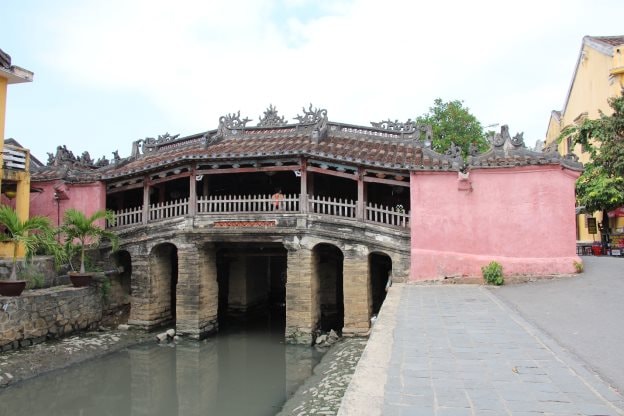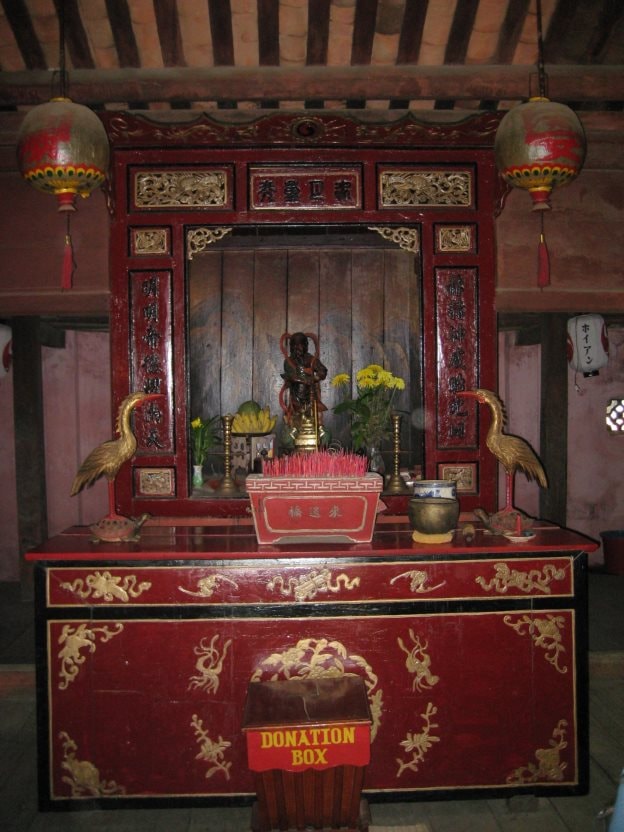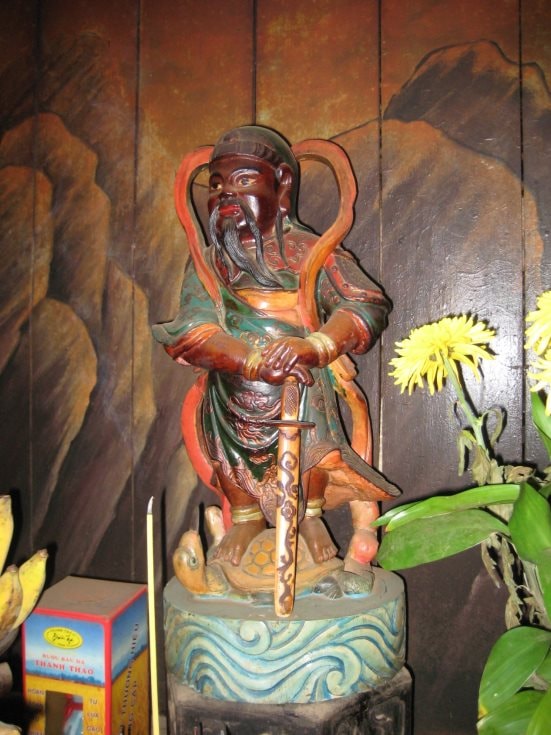
From the Namazu belief…
According to legend, the bridge was initiated and built by Japanese merchants because they saw waves often appearing on the surface of the Hoai River forming the back of the Namazu monster, a sea monster that the Vietnamese call Cu, the Japanese call Namazu, and the Chinese call Cau Long.
The Japanese believe that Namazu has its head in Japan, its tail in India, and its back across the gully (where the Japanese bridge crosses). Every time the monster wiggles its tail, Japan experiences an earthquake and Hoi An is not at peace. When settling in Hoi An, the Japanese built a bridge there like a sword stabbing right into the back of Namazu, preventing it from wagging its tail and causing an earthquake.
In Japanese mythology, Namazu has a giant body, so whenever it moves, its tail also moves, causing the earth to shake violently. Namazu is described as being imprisoned by the gods in the mud under the islands of Japan, but sometimes when the gods are not careful, Namazu will shake its body and cause terrible earthquakes.
…to the belief of the Northern Emperor Tran Vu
Northern Emperor Zhenwu, also known as Northern True Martial Mysterious Heavenly Emperor, Northern Holy True Monarch, Xuanwu Holy Monarch, True Martial Holy Monarch, Opening Heavenly Emperor, Yuanwu God… is one of the great gods worshiped in Chinese Taoism. He rules the North and the entire aquatic race (and is also a Water God).

In Hoi An, Bac De Tran Vu is solemnly worshiped in the center of the main hall of the Japanese Covered Bridge. The worship of Bac De is associated with the wish to control water, because Hoi An ancient town is located on the geological foundation of the wind and sea origin of the alluvial land downstream of the Thu Bon River.
Every year, this place has to endure many floods accompanied by storms. Whenever the flood rises, the rows of houses along the river are often submerged in water. Due to the harsh natural conditions, the residents at that time were unable to withstand the destruction of nature, they had to rely on supernatural forces to pray for protection.
Doctor A. Sallet was a French anthropologist in Central Vietnam. He came to Hoi An in the early 20th century. According to this researcher: “According to legend, when the pagoda and statue of Bac De were built, the purpose was to stop the disturbance of a demon who had built a cave there. It often moved, causing earthquakes and water to rise, scaring passersby and people on both banks. Bac De was assigned to control the demon and wanted to ensure that he could carry out his mission, he had to bury a golden sword before construction and four rocks with spells were placed at the four corners of the foundation.”
In the past, the Chinese community in Hoi An often held a ceremony to worship the Northern Emperor on the 20th day of the 7th lunar month every year. The ceremony was organized into a Long Chu procession that attracted a large number of people to participate, stretching through many streets, with the sound of octagonal music, trumpets, and drums, very bustling, to honor the authority of the Northern Emperor Tran Vu.
Albert Sallet added: “The ceremony to worship this god is on July 20. The ceremony is solemn and noisy. During the ceremony, a large paper boat with full equipment is placed and burned after the ceremony is over.” Currently at the Japanese Covered Bridge, Vietnamese and Chinese residents come to burn incense before the statue of Bac De to pray for the protection of the God.
Vietnamese - Chinese - Japanese culture at the Japanese Covered Bridge
According to legend, the reason for the Japanese bridge's construction was to prevent the Namazu water monster, and the Chinese community's worship of the Northern Emperor Tran Vu at the Japanese Covered Bridge has in common the desire to control the water, praying for stability in the local customs so that the local community can live and trade in peace. This shows the profound process of cultural exchange and mutual assimilation between the three ethnic groups of Vietnam - China - Japan.

Many existing sources show that both the bridge and the pagoda are works that demonstrate the collaboration and inheritance of the community of owners who once lived together in the commercial port of Hoi An in the investment of resources by the Japanese and Chinese, and the direct construction by the Vietnamese.
The Northern Emperor Tran Vu has the ability to control demons, protect the country and land, fight against natural disasters and bring happiness to people, which is also in line with the common wishes of Vietnamese people. Thus, the worship of Northern Emperor Tran Vu in Hoi An is a unique cultural feature.
It can be seen that the process of cultural exchange and acculturation through the legend of the construction of the bridge and the main god worshiped has partly shown the coexistence of the three ethnic communities of Vietnam - China - Japan in Hoi An land over the past centuries.
Source: https://baodanang.vn/su-cong-cu-nhin-tu-chua-cau-3302770.html


![[Photo] Many streets in Hanoi were flooded due to the effects of storm Bualoi](https://vphoto.vietnam.vn/thumb/1200x675/vietnam/resource/IMAGE/2025/9/29/18b658aa0fa2495c927ade4bbe0096df)
![[Photo] General Secretary To Lam attends the ceremony to celebrate the 80th anniversary of the post and telecommunications sector and the 66th anniversary of the science and technology sector.](https://vphoto.vietnam.vn/thumb/1200x675/vietnam/resource/IMAGE/2025/9/29/8e86b39b8fe44121a2b14a031f4cef46)
![[Photo] General Secretary To Lam receives US Ambassador to Vietnam Marc Knapper](https://vphoto.vietnam.vn/thumb/1200x675/vietnam/resource/IMAGE/2025/9/29/c8fd0761aa184da7814aee57d87c49b3)
![[Photo] General Secretary To Lam chairs the meeting of the Central Steering Committee on preventing and combating corruption, waste and negativity](https://vphoto.vietnam.vn/thumb/1200x675/vietnam/resource/IMAGE/2025/9/29/fb2a8712315d4213a16322588c57b975)
![[Photo] National Assembly Chairman Tran Thanh Man chairs the 8th Conference of full-time National Assembly deputies](https://vphoto.vietnam.vn/thumb/1200x675/vietnam/resource/IMAGE/2025/9/29/2c21459bc38d44ffaacd679ab9a0477c)


































































































Comment (0)